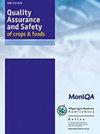强化面食加工和贮藏过程中铁和维生素A的稳定性评价
IF 5.3
3区 农林科学
Q1 FOOD SCIENCE & TECHNOLOGY
引用次数: 8
摘要
意大利面在改善人口营养状况方面具有更大的潜力,添加铁和维生素A等微量营养素可能是在饮食中提供必要营养的有效策略。这项研究量化了强化意大利面加工后和储存4个月期间两种不同微量营养素(铁和维生素A)的损失。铁的化学盐,即乙二胺四乙酸铁钠(NaFeEDTA)和硫酸亚铁(FeSO4),分别以4,5,6 mg/100g和6,7,8 mg/100g的量添加到意大利面配方中,而对于维生素A,乙酸视网膜酯(RA)的添加量分别为700,800和900µg/100g。加工后,用两种铁盐制备的意大利面显示出94–95%的铁保留率和90 92%的维生素A活性。铁和维生素A强化意大利面在加工过程中具有最大的保留率,并表现出最佳的颜色特性和感官评分,将其单独或组合(NaFeEDTA和RA)在25和40°C的层压材料(铝层压材料)和聚丙烯包装中储存4个月,并评估其铁和维生素A含量的变化。考虑到加工和储存过程中的损失,4个月后观察到93–95%的铁和56–62%的维生素A的总体保留率。温度的变化对铁的稳定性没有显著影响,而在40°C的加速温度下储存的意大利面,维生素a的损失为33-37%。在使用的两种包装材料中,层压板比聚丙烯保留了更多的铁和维生素A活性。单独强化或联合强化时,铁和维生素A的保留率没有差异。本文章由计算机程序翻译,如有差异,请以英文原文为准。
Stability evaluation of iron and vitamin A during processing and storage of fortified pasta
Pasta holds greater potential for improving the nutritional status of the population and its fortification with micronutrients like iron and vitamin A could be an effective strategy to provide the essential nutrients in the diet. This study quantified the losses of two different micronutrients (iron and vitamin A) in fortified pasta post processing and during storage for 4 months. Chemical salts of iron, namely, ferric sodium ethylene diamine tetra-acetic acid (NaFeEDTA) and ferrous sulphate (FeSO4), were added to pasta formulation at 4,5,6 mg/100g and 6,7,8 mg/100g respectively, whereas for vitamin A, retinyl acetate (RA) was added at 700, 800 and 900 µg/100g. After processing, the prepared pasta with both iron salts showed retention of 94–95% for iron and 90 92% of vitamin A activity. Iron and vitamin A-fortified pasta with maximum retention during processing and exhibiting optimum colour attributes and sensory score were stored alone and in combination (NaFeEDTA and RA) at 25 and 40 °C in laminates (aluminium laminates) and polypropylene packets for a period of 4 months and evaluated for changes in their iron and vitamin A contents. An overall retention of 93–95% of the iron and 56–62 % of vitamin A was observed after 4 months considering losses during processing and storage. Variations in temperature had a non-significant effect on the stability of iron, whereas for vitamin A a loss of 33–37% was noted for pasta stored at accelerated temperature of 40 °C. Among the two packaging materials used, laminates retained more of iron and vitamin A activity than polypropylene. No difference in retention rates was observed for iron and vitamin A when fortified alone or in combination.
求助全文
通过发布文献求助,成功后即可免费获取论文全文。
去求助
来源期刊

Quality Assurance and Safety of Crops & Foods
FOOD SCIENCE & TECHNOLOGY-
CiteScore
4.60
自引率
7.50%
发文量
61
审稿时长
1 months
期刊介绍:
''Quality Assurance and Safety of Crops & Foods'' is an international peer-reviewed journal publishing research and review papers associated with the quality and safety of food and food sources including cereals, grains, oilseeds, fruits, root crops and animal sources. It targets both primary materials and their conversion to human foods. There is a strong focus on the development and application of new analytical tools and their potential for quality assessment, assurance, control and safety. The scope includes issues of risk assessment, traceability, authenticity, food security and socio-economic impacts. Manuscripts presenting novel data and information that are likely to significantly contribute to scientific knowledge in areas of food quality and safety will be considered.
''Quality Assurance and Safety of Crops & Foods'' provides a forum for all those working in the specialist field of food quality and safety to report on the progress and outcomes of their research.
 求助内容:
求助内容: 应助结果提醒方式:
应助结果提醒方式:


